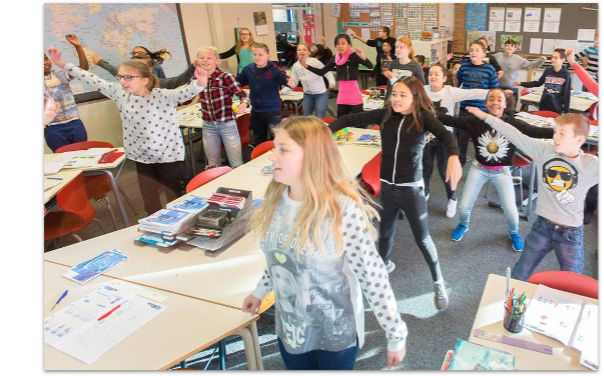What if exergames stimulated cognitive and physical development
Exergames
Games keep us busy. Whether it is marketing gamification or the badges you can earn with your running app, they are effective. Exergames contain all the game elements (goal-oriented, set of rules, challenge, feedback), but combine that with exercise, explains Sluis-Thiescheffer: "An exergame is designed to stimulate physical activity. They make it easier to concentrate on the activity, lower the threshold and sometimes give you a push. Even the app you use to log cycling or running activities contains a few 'playful' elements, but a real exergame lets you move in a playful way."
Swimming games, rocking chairs and rehabilitation
Fontys has been working with various partners on exergames for a long time. An example is the development of an interactive swimming pool, where there are many game possibilities for aqua sport, therapeutic activities and swimming for the elderly. Or a project to make sitting more active by using benches with sensors that stimulate interaction with light, sound or another bench. What Sluis-Thiescheffer is particularly proud of are gamification projects with rehabilitation training: "Children with cerebral palsy often sit for an hour and a half a day for exercises on a bicycle trainer. That is boring and monotonous, they even fall asleep during it. By linking a game to this, which plays with the resistance of the cycletrainer, you can remedy this. The pleasure in training then goes up, as does the participation and ultimately the success of the rehabilitation."
Learning to do maths better while moving?
Exergames and movement-based learning are not new, but the innovation opportunity lies in linking cognitive development and movement, according to Sluis-Thiesscheffer: "By bringing the two together, you ensure the efficient integration of movement into existing lessons. We want to monitor the movement development of pupils and see what links we can make on the basis of that data. For example, a student who needs to develop ball control, but who also needs to learn his times tables, can be offered a ball game with sums. Our partners Embedded Fitness and Picoo have developed technology for this, which we also have in-house. This allows us to develop and test our own exergames so that we can take physical activity stimulation in primary education to the next level. That is the kind of exploration we want to do within this project." Besides the combination of cognition and exercise, there are of course more opportunities; data can help tailor education even more to individual students. This is what the project aims to recognise in an exploratory trajectory over the coming year.
Vitality Living Lab
The project GROWTHmoves: exergames for the base has been honoured with a KIEM GoCI grant for one year of exploratory research by National Regieorgaan SIA and takes place within the Vitality Living Lab project. It is part of the Vitality Living Lab project in collaboration with Fontys Sports College, Fontys Hogeschool Pedagogy and network partner Sports and Technology. In the development of exergames, Fontys works together with Embedded Fitness and Picoo. During the Elis Innovation Summit 2021 on December 8th the project Exergames will be presented.
Want to know more about exergames? Please contact Wouter Sluis-Thiesscheffer.
